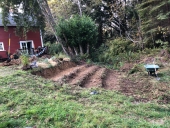Remember in my first post how I'd mentioned you all taking the opportunity to learn from my negative experiences rather than making then yourself? Well, in the past 2 weeks, I've been hit with a double whammy of hugelkulture"learning experiences". In short: be aware that buliding sunken huglebeets are going to involve topping the new bed with sub soil (unless you already have very deep topsoil) and that the dirt you dig up to top the hugelbeet with will leave behind a pit that, if filled with rain
water, will become a breeding ground for mosquitoes. Hello Dengue Fever!
Believe it or not, this is the "soil" on top of the hugelbeet a week after I painstakingly slung it up there. None of the oat grass or cow peas I sowed have made an appearance but the quack grass is doing just fine; go figure. Sure, there is a smorgasbord of nutrients, organic matter and retained water underneath, but the dirt appears to be completely unaware. In fact, this layer of sun baked clay is harder than pre-calculus. What I have been doing since this photo was taken is putting on alternating layers of dirt and leaves. Hopefully the OM turns the subsoil into something that will behave a little bit more like topsoil.
See that knee deep pool of mud water? If you look close, you might see the mosquitoes making sweet love. I wound up bailing out the water like a sailor on a sinking ship, all the while swearing like said sailor as the mosquitoes had a field day with my juicy, tender calves. Only after 5 days, through a combination of bailing and evaporation, the hole dried up and I was finally able to get back to digging. Don't leave half dug pits at the end of the day. If it rains and fills up that pit, you are going to have to wait for it to dry up to go anywhere near it without getting eaten alive, much less do any actual digging. Dig it all the way so that even if it rains, you can fill up that pit with some
wood and mulch to soak up the water and deny access to flying parasites.
Hugelkulture by hand is demanding
enough as it is. You don't want mosquitoes feeding on you while you labor, nor do you want your new bed unusable to anything aside from creeping grass because you neglected to mix organic material in with your subsoil topping. An ounce of prevention, my fellow permies!
Note: this is copy-pasted from my blog (url in my signature). Some of the more colorful language and similes are edited out or replaced with something a little more family friendly.


















 1
1








 1
1


















